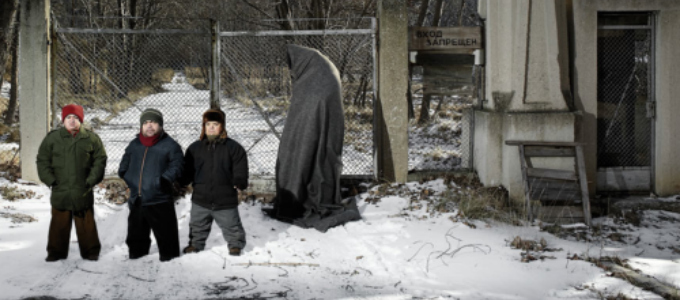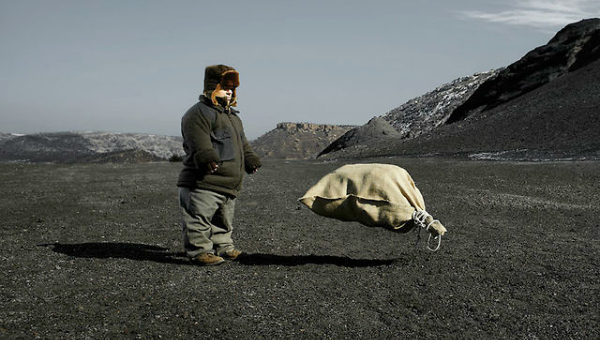 Surrealism can be a tricky thing to get right. When you start to see objects as characters and when your defining purpose is to find what’s illogical rather than logical, if you’ve failed to ground your world in something substantial then it’s all just a collection of images, no matter how interesting those images might be. Sergio Caballero’s second feature employs both a very physical grounding, in the environs of a derelict power station, and also uses the distinct structure of a heist movie to give shape and form to his imagination.
Surrealism can be a tricky thing to get right. When you start to see objects as characters and when your defining purpose is to find what’s illogical rather than logical, if you’ve failed to ground your world in something substantial then it’s all just a collection of images, no matter how interesting those images might be. Sergio Caballero’s second feature employs both a very physical grounding, in the environs of a derelict power station, and also uses the distinct structure of a heist movie to give shape and form to his imagination.While the sense of the form is conventional, almost a staple of the language of film, the details layered over it most certainly are not. Taking an inspiration from David Lynch, Caballero has cast not one but three dwarves as his central characters, a trio with various psychic powers that they use to be able to conduct their business. Additionally, they (and all of the other characters, whether animate or inanimate) are telepathic, speaking in a variety of languages but able to clearly communicate. Their services are required by a performance artist who was bought and installed in a Siberian power plant by a now deceased Russian oligarch; the artist seeks an object held at the same facility called The Distance and the dwarves concoct an elaborate plan to acquire it for him.
Caballero has stated in interviews that he no longer watches anything but children’s television, believing other culture will contaminate his own creative process. Maybe because of that he’s chosen as his leaping off point elements from Andrei Tarkovsky’s film STALKER, but instead of The Zone, The Room, The Writer and The Professor as in STALKER, Caballero has The Bucket and The Chimney in addition to The Distance. Other elements, from the telekinesis to the oppressive Russian landscape, also have their roots in Tarkovsky’s work, although the sexually-obsessed dwarf whose powers are activated by scratching his crotch and then sniffing his fingers appears to be entirely of Caballero’s invention.
Caballero instead finds glimmers of human truth and dark comedy among the freakish…
What keeps THE DISTANCE watchable throughout is the relationship between the three central characters. Caballero’s process involves taking ideas recorded on his iPhone, then expanding them on set and only finally forming the narrative in the editing suite, so it comes as a pleasant surprise that the narrative underpinning the film is as coherent as it is. Within that the dwarves’ relationships, a three way odd couple that provides both occasional flashes of emotion and humour which give the bedrock that allows the more eccentric elements to flourish. There are other character successes within the film, most notably a haiku-spouting Japanese bucket, but THE DISTANCE is primarily a visual film and on that level is impressive, Caballero’s imagery perfectly complemented by Marc Gómez de Moria’s cinematography which finds beauty in the harsh Spanish landscapes doubling for Siberia.
Given his aversion to modern culture and his inspiration from Tarkovsky, THE DISTANCE would seem to be Caballero’s attempt to puncture the pomposity of some of the darker recesses of cinema. There’s lightness and hope among the depression and despair in the world that he’s created, but it’s the darkness that’s the dominant force. Rather than the approach of early classics of surrealist cinema, which sought to find disturbing images or horror among the mundane, Caballero instead finds glimmers of human truth and dark comedy among the freakish, but if his primary goal was to entertain, it’s one he’s achieved admirably. While The Distance itself feels very much a MacGuffin, the final reveal still makes for a memorable climax to an arresting film.
THE DISTANCE screened at the Cambridge Film Festival alongside the short, ANCHA ES QUESTILLA / N’IMPORTE QUOI, which while equally surreal is anarchic, boisterous and deliberately messy, in sharp contrast to almost every element of THE DISTANCE. Mixing puppets made of food with actors occasionally playing the same characters, it’s a story of exorcism that draws inspiration from other surrealists and for anyone that might find THE DISTANCE too remote or abstract, the daft liveliness of ANCHA ES QUESTILLA should provide a thorough antidote.
httpvh://youtu.be/VgE5cIcvz90

